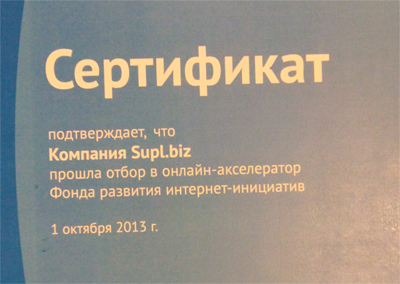FRIA Online Accelerator

In this article we will talk about how we went through the online acceleration in the Internet Initiatives Development Fund (IIDF), what benefits we got and what conclusions we reached.
In the first set of IIDF there were two forms of accelerator:
1. Offline acceleration includes an investment of $ 25,000 for 7% of the company, and the necessary conditions are the relocation of 2-3 team members to the IIDF co-working for 3 months and attendance of lectures.
2. Online - a remote form of acceleration, in which the team works with its tracker on skype, sets goals and reports on their implementation. Lectures can be watched in video or attend in person if you are in Moscow.
')
Acceleration lasts 3 months. IIDF stated that after leaving the accelerator, all projects will have equal conditions to appear before investors on Demo Day and attract up to $ 450,000 of investments from IIDF.
We got into the online accelerator, but for other business I moved to Moscow, so I had the opportunity to attend lectures and other events.
How did we get into the online accelerator? First, we submitted an application (the full text of our application via the link ), then there was a 15-minute skype-interview, and after a couple of weeks we learned that we were in the TOP-100. Then there was the Day of the selection of projects in offline, where I spoke with a 5-minute report to the experts.
In fact, we had a desire to go offline, but we hesitated: moving three members of the team for 3 months to Moscow meant that we would lower all the $ 25,000 investments for food (lodging, food, flights). As a result, we have not gone offline. Of course, they were a little upset that they did not go through some kind of competition, but they understood that it was not much for us and wanted to give 7% of the company “for food”.
The online acceleration looked like this: first, we defined the metrics of our project (measurable numerical parameters that characterize success), then once a week we called up the tracker, discussed plans and current metrics.
At the same time, I occasionally attended lectures in the IIDF. For example, I really liked the lecture of the head of the PR department of SuperJob Anna Chukseyeva. Anna agreed to advise our PR project on an ongoing basis - this is perhaps the most important thing that we received from IIDF.
It was very interesting to listen to the lectures of his countrymen from Tomsk. Stas Yeleseev and Evgeny Fields (UserStory) talked about UI and UX. We also started cooperation with these guys. Daniel Hanin from Crossss should have talked about the market assessment, but it turned out to be a rather inspiring lecture about ambition.
Sadly, FRIA almost forgot about projects from the online accelerator: there were almost no videos of lectures, and at the end of the accelerator, FRIA set up a stand, not allowing almost all of it online until Demo Day. When people first promise one thing, and then deliberately do the exact opposite - it is somehow unpleasant.
Despite the ugly behavior of the FRIA leadership, we really enjoyed talking with the lecturers and our tracker Nikolai Kotkin. By the way, Nikolai has his own startup - dropup.ru, which we really liked, and which we plan to use in one of our projects. Fyodor Skuratov (I don’t even know what his position in IIDF) solved or tried to solve all our problems and requests: whoever we addressed with any question, everyone sent us to someone and in the end the chain closed on Fedore. We even got the impression that Fedor is working alone in the Fund, and all the others will only redirect.
It was very interesting to get acquainted with the venture capital investment market in Russia. He's kind of weird. For me, a classic venture investor is Andy Bechtolsheim , who wrote a check for $ 100,000 to the name of the defunct company Google Inc., because he liked their product, and he hoped to get his money back with a factor of 100 or 1,000 (even 17 000).
Russian venture capital investors prefer to invest in projects that have ARPU indicators, etc., while none of the investors want to look at the product itself, only financial indicators are important. It feels like it is more interesting for them to invest in a business with ambitions of a vegetable kiosk in the yard: there is almost no ARPU and there are almost no risks, and a conversion of 5% from people passing by. I exaggerate, of course, but the impressions are exactly like that. Venture fund managers would need to listen to Daniil Khanin’s lecture on ambition.
By the way, on exit from the online, IIDF invited us to offline the accelerator. But we still do not want to give 7% of the company for the “food”. In addition, it is not very convenient to detach 2-3 team members from other colleagues and close people in Tomsk. Therefore, we refused this offer. Of course, it flattered us that for 7% of the share of the FIDI was ready to invest in us $ 25,000 in money (+ $ 20,000 with its services), which gives a total project estimate of 20 million rubles. It is nice to know that in a year we have created a company that is estimated at such a sum.
As a result, a very wide range of emotions remained from participation in the IIDF project. In any case, we are very glad that these 3 months participated in their online accelerator. During this time, almost all indicators on our project increased 4 times: the number of orders, the number of responses, the attendance of the resource. And we are happy that every day we hear and read the positive feedback from our users about Supl.biz .
Source: https://habr.com/ru/post/210640/
All Articles